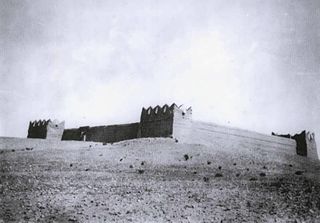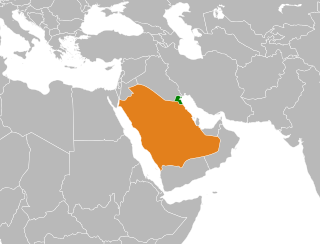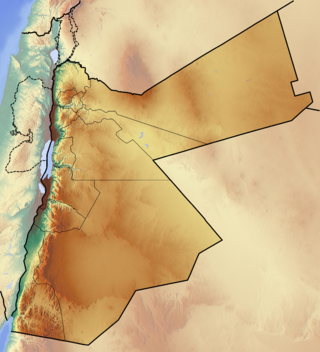
The Iraq–Saudi Arabia border is 811 km (504 mi) in length and runs from the tripoint with Jordan in the west to the tripoint with Kuwait in the east. [1]

The Iraq–Saudi Arabia border is 811 km (504 mi) in length and runs from the tripoint with Jordan in the west to the tripoint with Kuwait in the east. [1]
The border starts on the west at the tripoint with Jordan, and consists of six straight lines broadly orientated to the south-east, eventually reaching the tripoint with Kuwait on the Wadi al-Batin.

Historically there was no clearly defined boundary in this part of the Arabian peninsula; at the start of the 20th century the Ottoman Empire controlled what is now Iraq, with areas further south consisting of loosely organised Arab groupings, occasionally forming emirates, most prominent of which was the Emirate of Nejd and Hasa ruled by the al-Saud family. [2] [3]
During the First World War an Arab Revolt, supported by Britain, succeeded in removing the Ottomans from most of the Middle East. As a result of the secret 1916 Anglo-French Sykes-Picot Agreement Britain gained control of the Ottoman Vilayets of Mosul, Baghdad and Basra, which it organised into the mandate of Iraq in 1920. [3] In the meantime Ibn Saud had managed to expand his domains considerably, eventually proclaiming the Kingdom of Saudi Arabia in 1932.
In December 1922 Percy Cox, British High Commissioner in Iraq, met with ibn Saud and signed the Uqair Protocol, which finalised Saudi Arabia's borders with both Kuwait and Iraq. [3] The border thus created differed slightly from the modern frontier, with a Saudi 'kink' in the middle-south section. It also created a Saudi–Iraqi neutral zone, immediately west of Kuwait. This border was confirmed by the Bahra Agreement in November 1925. [4]
The Saudi-Iraq neutral zone was split in 1975 and a final border treaty signed in 1981, [5] which also appears to have 'ironed out' the Saudi kink. [6] [7] The details of this treaty were not revealed until 1991 when Saudi Arabia deposited the agreements at the United Nations following the Gulf War. [8] The Gulf War seriously strained relations between the two countries; Iraq fired scud missiles into Saudi territory and also breached the Kuwait–Saudi Arabia border. [9]
| Saudi–Iraq barrier | |
|---|---|
| Saudi Arabia–Iraq border | |
| Type | Border barrier |
| Site information | |
| Controlled by | |
| Condition | Active |
| Site history | |
| Built | 2014 |
| Built by | |
| In use | 2014–present |
| Battles/wars | Iraqi Civil War (2014–2017) |
In April 2006, while Iraq was experiencing a high level of sectarian violence, Saudi Arabia began to call for tenders to construct a border barrier in the form of a fence along the border in an attempt to prevent the violence in Iraq spilling over into its territory. [10] The proposed fence would run for approximately 900 kilometres (560 mi) along Saudi Arabia's isolated northern desert border with Iraq. It was part of a larger package of fence-building to secure all of the Saudi Arabia's 6,500 km (4,039 mi) of border. It would supplement the existing 7-meter-high sand berm that runs along the border, in front of which there is an 8-km stretch of no-mans-land which is regularly swept smooth so that trespassers can be tracked. [11]
The proposals were not implemented until September 2014, when the Iraqi Civil War had escalated following the rise of the Islamic State of Iraq and the Levant. ISIL's occupation of much of western Iraq had given it a substantial land border with Saudi Arabia to the south, and the barrier is intended to keep ISIL militants from entering Saudi Arabia. [12] The line consists of a multi-layered fence and ditch barrier wall. The border zone includes five layers of fencing with includes 78 monitoring watch towers, night-vision cameras, and radar cameras, eight command centres, 10 mobile surveillance vehicles, 32 rapid-response centres, and three rapid intervention squads. [13] [14] The works were completed with the assistance of Airbus, a European multinational aerospace corporation. [15]

The history of Saudi Arabia as a nation state began with the emergence of the Al Saud dynasty in central Arabia in 1727 and the subsequent establishment of the Emirate of Diriyah. Pre-Islamic Arabia, the territory that constitutes modern Saudi Arabia, was the site of several ancient cultures and civilizations; the prehistory of Saudi Arabia shows some of the earliest traces of human activity in the world.

The Kingdom of Saudi Arabia is a country situated in West Asia, the largest country on the Arabian Peninsula, bordering the Persian Gulf and the Red Sea. Its extensive coastlines provide great leverage on shipping through the Persian Gulf and the Suez Canal. The kingdom occupies 80% of the Arabian Peninsula. Most of the country's boundaries with the United Arab Emirates (UAE), Oman, and the Republic of Yemen are undefined, so the exact size of the country remains unknown. The Saudi government estimate is at 2,217,949 square kilometres, while other reputable estimates vary between 2,149,690 and 2,240,000 sq. kilometres. Less than 7% of the total area is suitable for cultivation, and in the early 1960s, population distribution varied greatly among the towns of the eastern and western coastal areas, the densely populated interior oases, and the vast, almost empty deserts.

The Saudi Arabian–Iraqi neutral zone was an area of 7,044 km2 on the border between Saudi Arabia and Iraq within which the border between the two countries had not been settled. The neutral zone came into existence following the Uqair Protocol of 1922 that defined the border between Iraq and the Sultanate of Nejd. An agreement to partition the neutral zone was reached by Iraqi and Saudi representatives on 26 December 1981, and approved by the Iraqi National Assembly on 28 January 1982. The territory was divided on an unknown date between 28 January and 30 July 1982. Notice was given to the United Nations in June 1991.
The Uqair Protocol or Uqair Convention was an agreement at Uqair on 2 December 1922 that defined the boundaries between Mandatory Iraq, the Sultanate of Nejd and Sheikhdom of Kuwait. It was made by Percy Cox, the British High Commissioner to Iraq, in response to Ikhwan raiders from Nejd under Ibn Saud. Cox met ibn Saud and Major John More, the British Political Agent to Kuwait. The boundaries included a Saudi–Iraqi neutral zone and a Saudi–Kuwaiti neutral zone.

Abdul Rahman bin Faisal Al Saud was the last emir of Nejd, reigning from 1875 to 1876 and from 1889 to 1891. He was the youngest son of Emir Faisal bin Turki bin Abdullah and the father of Abdulaziz, the founder of the Kingdom of Saudi Arabia.

The Unification of Saudi Arabia was a military and political campaign in which the various tribes, sheikhdoms, city-states, emirates, and kingdoms of most of the central Arabian Peninsula were conquered by the House of Saud, or Al Saud. Unification started in 1902 and continued until 1932, when the Kingdom of Saudi Arabia was proclaimed under the leadership of Abdulaziz, known in the West as Ibn Saud, creating what is sometimes referred to as the Third Saudi State, to differentiate it from the Emirate of Diriyah, the First Saudi State and the Emirate of Nejd, the Second Saudi State, also House of Saud states.

Iraq–Saudi relations are the bilateral and diplomatic relations between the Republic of Iraq and the Kingdom of Saudi Arabia. Both sovereign states share the Iraq–Saudi Arabia border.

The Kuwait–Najd War erupted in the aftermath of World War I. The war occurred because Ibn Saud of Najd wanted to annex Kuwait. The sharpened conflict between Kuwait and Najd led to the death of hundreds of Kuwaitis. The war resulted in sporadic border clashes throughout 1919–1920.

In the aftermath of World War I, King Ibn Saud wanted to annex Kuwait into Saudi Arabia. Border conflicts were fought in 1919–1920, in which the Kuwaitis successfully fought them off with British assistance. Following the war the Saudis imposed a trade blockade on Kuwait from 1923 until 1937, which heavily impacted the Kuwaiti economy. The goal of the Saudi pressure was to annex as much Kuwaiti territory as possible. At the Uqair conference of 1922 which was convened to decide on the borders between some of the newly formed Arab states, Ibn Saud succeeded in persuading British diplomat Sir Percy Cox, the high commissioner in Iraq, to give the Saudis two-thirds of Kuwaiti territory. There were no Kuwaiti representatives at the conference. This event set Kuwait's modern boundaries.

The sanjak of Najd was a sanjak of the Ottoman Empire. The name is considered misleading, as it covered the al-Hasa region, rather than the much larger Najd region. It was part of Baghdad Vilayet from June 1871 to 1875, when it became part of the Basra Vilayet.

The Jordan–Syria border is 362 km in length and runs from the tripoint with Israel in the west to the tripoint with Iraq in the east.

The Iraq–Jordan border is 179 km in length and runs from the tripoint with Syria in the north to the tripoint with Saudi Arabia in the south.

The Jordan–Saudi Arabia border is 731 km (454 mi) in length and runs from the Gulf of Aqaba in the south-west to the tripoint with Iraq in the north-east.

The Iraq–Kuwait border is 254 km in length and runs from the tripoint with Saudi Arabia in the west to the Persian Gulf coast in the east.

The Kuwait–Saudi Arabia border is 221 km in length and runs from the tripoint with Iraq in the west to the Persian Gulf coast in the east.

The Qatar–Saudi Arabia border is 87 km (54 mi) in length and runs from the Gulf of Bahrain coast in the west to the Persian Gulf coast in the east.

The Saudi Arabia–United Arab Emirates border is 457 km (284 mi) in length and runs from the Persian Gulf coast in the west to the tripoint with Oman in the east.

The Oman–Saudi Arabia border is 658 km in length and runs from the tripoint with the United Arab Emirates in the north to the tripoint with Yemen in the south-west.

The Saudi Arabia–Yemen border is 1,307 km (812 mi) in length and runs from the Red Sea coast in the west to the tripoint with Oman in the east.

The Declaration of theUnification of Saudi Arabia was officially announced by Prince Faisal bin Abdulaziz, the Viceroy of Hejaz on behalf of King Abdulaziz ibn Saud on September 23, 1932, at 9:00 am from al-Hamidiyah Palace in Mecca. Faisal read out the Royal Decree No. 2716 issued by Abdulaziz ibn Saud on September 18, 1932, that renamed the Kingdom of Hejaz and Nejd and its annexes as the Kingdom of Saudi Arabia.